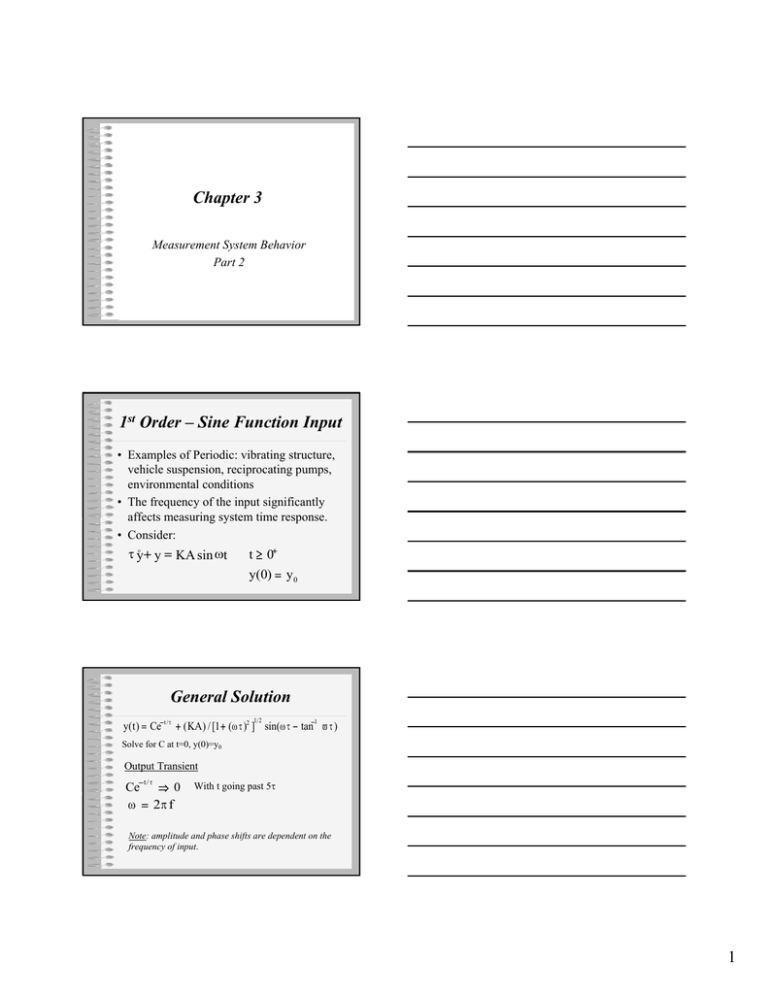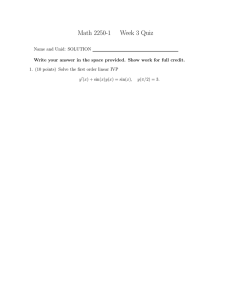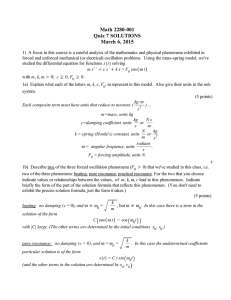Chapter 3 1st Order – Sine Function Input General Solution
advertisement

Chapter 3
Measurement System Behavior
Part 2
1st Order – Sine Function Input
• Examples of Periodic: vibrating structure,
vehicle suspension, reciprocating pumps,
environmental conditions
• The frequency of the input significantly
affects measuring system time response.
• Consider:
τ y + y = KA sin ωt
o
t ≥ 0+
y(0) = y 0
General Solution
1/ 2
y( t ) = Ce− t / τ + ( KA ) / [1 + (ω τ )2 ] sin(ω τ − tan−1 ϖ τ )
Solve for C at t=0, y(0)=y0
Output Transient
− t /τ
Ce ⇒ 0
ω = 2π f
With t going past 5τ
Note: amplitude and phase shifts are dependent on the
frequency of input.
1
Output Steady State
• Amplitude and phase shift are functions of
input frequency
• Output frequency is the same as input
frequency
• Output remains as long as the forcing
function
Rewritten:
y ( t ) = Ce −
t /t
+ B(w ) sin[wt + j(w )]
Magnitude:
B(ω ) = ( KA ) / [1+ (ωτ) 2 ]
1/ 2
Phase Shift:
ϕ (ω ) = − tan−1 ω τ
Where τ is the time constant.
Time Delay
β1 = (ϕ (ω ))/ω
Value of β1 is negative,
indicating a time delay
between input and output.
Magnitude ratio of
input/output:
m(ω)=B/KA=1/(1+(ωτ)21/2
Note the frequency
dependency
2
Freq response: magnitude ratio (Figliola, 3rd)
• For value of wτ which
gives m(ω) near unity.
The first order MS will
transmit nearly all of
the input signal with
little delay or
attenuation of signal.
• B(ω)≈KA, ϕ(ω)≈∅o
• If you want to monitor
an input signal with
high frequency, you
will need τ to be very
small in order to give
m(ω)≈1
Freq response: phase shift (Figliola, 3rd)
Dynamic Error
• δ(ω) = m(ω) – 1
– measures systems inability to adequately
reconstruct the amplitude of input at a given
frequency.
• Want to minimize δ(ω)
• Perfect reproduction is not possible
Frequency Bandwidth
• Frequency band over which m(ω)≥0.707 or
where dB=20 log m(ω1) does not drop more than
–3 dB between ωn and ωm for a given τ
• dB=20 log m(ωn) + 20 log m(ωm)
• dB=20 log (1) + 20 log (0.4)
• dB=-7.95
3
Determination of Frequency
Response
• The frequency response is found by dynamic
calibration, by applying a simple periodic
waveform input to the sensor stage and
monitoring the output. However, this can be
impractical in some physical systems.
– Model system frequency response
– Calibrate components independently and then
combine them to develop system.
• Ex: (load cell and transmitter) calibration
• Range 0 to 40,000 lbs
Determination of Frequency
Response con’t:
– Load cell is calibrated in factory
– 4-20MA transmitter calibrated using an analog
signal represents the range of the load cell – 0
to 30mv/volt
• Load cell and transmitter are loaded with
test weights to confirm approximate range
(0 to 30,000 lbs max available)
2nd Order System
• Possesses inertia and contains a second
deviative term, such as accelerometers,
diaphragm pressure transducers, and
acoustic microphones.
oo
o
a 2 y + a1 y + a 0 y = F( t )
oo
or
o
(1 / ( wn )) y + (2ζ y) / wn + y = KF( t )
2
where
wn =
a 0 / a 2 = natural frequency
4
2nd Order System
•
ζ = a1/(2(a 0a 2)12/ )
Zeta= damping ratio
• The damping ratio is a measure of system
damping, a property of a system that
enables it to dissipate energy internally.
Homogeneous solution
• Quadratic equations have two roots
1/( wn2 )λ2 + (2ζ / wn) λ + 1= 0
> > λ 1,λ 2
λ 1, λ 2 = − ζ wn ± wn ζ 2 − 1
•Homogeneous solution gives us the transient response
•Finds the roots of the characteristic equation
• The three forms of homogeneous solution
depend on the value of damping
• 0<ζ<1 (underdamped) – oscillatory
response
− ζ wnt
yh( t ) = Ce
sin( wn 1 − ζ 2 t + θ
• ζ=1 (critically damped- asymptotically approaches SS)
λ t
yh( t ) = C1e 1 + C2 teλ 2 t
• ζ>1 (overdamped)
yh( t ) = C1eλ 1t + C2eλ 2 t
5
Step Function Response
• Response equation given in
text – 3.15a-3.15c
¾ ζ=1 (critically damped)
Td =
2π
ωd
¾ Y(t)=KA-KA(1+ ωnt)e- ω nt)
• For an underdamped
system, the transient
response is oscillatory,
with a periodic behavior of
period
2π
Td =
ωd ,
with ringing frequency
wd = wn 1 − ζ 2
Note: this is dependent on the instrument, not the signal
Ringing
• In instruments, this oscillatory behavior is
called “ringing.”
• The ringing phenomenon and the
associated ringing frequency are properties
of the measurement system and are
independent of the input signal.
• It is the free oscillation frequency of a
system displaced from its equilibrium.
1. Duration of transient response controlled by
ζωn. For ζ>1, the response y∞ÆKA at tÆ∞,
but for larger ζωn the response is faster.
2. Time required to reach 90% of step input
Au(t)=KA-y0 is called rise time. Rise time is
decreased by decreasing the damping ratio
ζ.
3. Time to reach ±10% of steady state is called
settling time for oscillatory systems.
Note: a faster rise may not necessarily reach a steady
state faster if the oscillations are large.
6
Note: Rise time; settling time
Sine Function Input
• Response of 2nd order system to F(t)=A sin ωt
y( t ) = yh + {___________________
KA sin[ wt + ϕ ( w )]}
2
{[1 − ( w / wn) 2] + (2ζ w / wn) 2}1/ 2
• Frequency dependent phase shift
ϕ ( w ) = − tan−1(2ζ w / wn ) / (1 − ( w / wn )2 )
Exact form of yh depends on (ζ) damping ratio
Note: h = homogeneous solution
Steady State Response
• Ysteady(t)=β(ω) sin [ωt+ϕ(ω)]
• Amplitude:
B(ω)=KA/{[1-(ω/ ωn)2]2+(2ζ ω/ ωn)2}1/2
• The amplitude of the output signal from a
second-order measurement system is frequency
dependent.
7
Magnitude Ratio
• Magnitude Ratio:
m(ω) = B/KA
• ωn is a function of the measurement system
• ω is a function of the input signal
Magnitude Ratio
• Fig 3.16 and Fig 3.17
in text demonstrate
magnitude and phase
as functions of ω/ ωn
• In ideal system,
m(ω)=1.0 and
ϕ(ω)=0
• In general, as ω/ ωn
gets large, m(ω)Æ0
and ϕ(ω)Æ-π
Phase Shift
8
Resonance Frequency
wr = wn 1 − 2ζ 2
• It is a property of MS, operating near resonance
frequency. It can damage or distort either the data or
the instrument.
• When ω = ωn, m(ω) Æ ∞, and ϕ(ω) Æ -π, it occurs
for the underdamped system ζ = 0. It is called the
resonance band.
• Systems with damping ζ > 0.7 do not resonate.
Resonance Frequency cont:
• At low ω/ ωn, m(ω) ≈ 1 and ϕ(ω) ≈ 0. This is called the
transmission band, which is defined by
3dB ≥ m(ω) ≥ -3dB.
• Here we have a representation of the dynamic
signal content.
• At large ω/ ωn, m(ω) Æ0, which is called the filter band
• m(ω) ≤ -3dB
• Here we lose high frequency signal content, which
is good only if you want low frequency
information!
Resonance Frequency cont:
9
Multiple-Function Inputs
• When models are used that are linear,
ordinary differential equations subjected to
inputs that are linear in terms of the
dependent variable, the principle of
superposition of linear systems will apply
to the solution of these equations.
Principle of Superposition
• The theory of superposition states that a
linear combination of input signals applied
to a linear measurement system produces
an output signal that is simply the linear
addition of the separate output signals that
would result if each input term had been
applied separately.
Principle of Superposition
• The forcing function of a form:
∞
F (t ) = A0 + ∑ ( Ai sin ωi t )
i =1
is applied to a system, then the combined steady
response will have the form:
∞
KA0 + ∑ B(ωi ) sin[ωi t + φ (ωi )]
n =1
Where B(ωi)=KAiM(ωi)
10
Coupled Systems
• When a measurement system consists of
more than one instrument, the
measurement system behavior can become
more complicated.
• As instruments in each stage of the system
are connected, the output from one stage
becomes the input to the next stage and so
forth.
Coupled Systems
• Such measurement systems will have an output
response to the original input signal that is some
combination of the individual instrument
responses to the input.
• The system concepts of zero-, first-, and secondorder systems studied previously can be used for a
case-by-case study of the coupled measurement
system.
• This is done by considering the input to each stage
of the measurement system as the output of the
previous stage.
11
Coupled Systems
• The previous slide depicts a measurement
system consisting of H interconnected
devices, j = 1, 2, …, H, each device
described by a linear system model.
Coupled Systems
• The overall transfer function of the
combined system, G(s), will be the product
of the transfer functions of each of the
individual devices, Gj(s), such that:
KG(s) = K1G1(s)K2G2(s)…KHGH(s)
• The overall system static sensitivity is
described by:
K = K1K2K3…KH
• The overall system magnitude ratio will be
the product:
M(ω) = M1(ω)M2(ω)…MH(ω)
• The overall system phase shift will be the
sum:
φ(ω) = φ1(ω) + φ2(ω) +…+ φH(ω)
12

